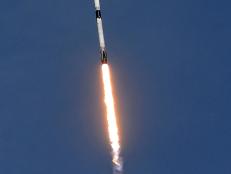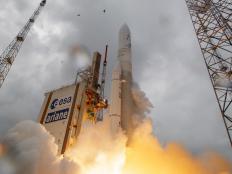All Space Articles
Showing 106 - 120 of 491 results
Water Molecules Found on Sunlit Surface of the Moon!
Breaking News! At 12P ET today, October 26, NASA announced a new discovery about the Moon. Here are the agency’s findings resulting from the world’s largest airborne observatory, SOFIA.
NASA and SpaceX are Going on a Date, and We're All Invited
Save the date--On May 27th, if everything goes as planned, a rocket will launch from Kennedy Space Center in Cape Canaveral, Florida. Watch SPACE LAUNCH LIVE: AMERICA RETURNS TO SPACE on Discovery and Science Channel starting at 2P ET.
When Did the First Stars Shine?
Our universe is home to up to two trillion galaxies, with each galaxy hosting hundreds of billions of stars. That’s…a lot of stars. Each one a ball of fearsome energies, powered by the nuclear fusion of fundamental elements in their hearts. Each one pouring out light into the empty cosmos, illuminating our universe for our wonder and delight.
Success! NASA and SpaceX Crew-1 Complete Early Morning Splashdown
(Updated: May 2, 2021) NASA astronauts Michael Hopkins, Victor Glover, Shannon Walker, and JAXA astronaut Soichi Noguchi completed a successful splashdown on Sunday, May 2, after a 165-day space research mission aboard the International Space Station. Here is what we know about their return to Earth.
SpaceX Test Flight Ends in Explosion
An experimental rocket launched by SpaceX on Wednesday, December 9 exploded after launching 8 miles into the air. Elon Musk says that this test was still a success.
Looking Ahead to 2021 in Space
As the year 2020 comes to close, it’s time to look ahead to 2021 and what’s to come in space exploration. From crewed launches to the ISS and Perseverance landing on Mars, it’s shaping up to be a busy year in space. Let’s take a look!
Celebrating 20 Years of Food in Space on the ISS
This year marks the 20th anniversary of continuous human presence aboard the International Space Station. Do you ever wonder what the astronauts have been eating for the past 20 years in zero gravity? Let’s find out!
Watch NASA Astronauts Return Home Live on Aug 2
NASA Astronauts Bob Behnken and Doug Hurley are scheduled to arrive home from space on Sunday, August 2. Watch SPACE LAUNCH LIVE: SPLASHDOWN on Discovery and Science Channel starting at 1PM ET.
James Webb Space Telescope Successfully Reached Its Final Destination
Nearly a month after the James Webb Space Telescope launched from French Guiana on December 25, the telescope has reached its final destination–almost a million miles from Earth.
This Year, James Webb will Take a Close Look at a Lava World
The James Webb Space Telescope is gearing up to be an exoplanet extraordinaire. Among many other missions and targets, astronomers plan to use the observatory, now in its final stages of preparations to study…well, a world where it might rain lava.
NASA’s DART Mission Launches: Defending our Planet from an Asteroid
NASA’s first mission to test asteroid deflection technology launched yesterday. DART, or Double Asteroid Redirection Test, is a mission to slam a rocket into an asteroid… hopefully altering its path.
All Aboard the James Webb Space Telescope!
All hail the James Webb, the ultra-powerful super-telescope for the next generation. Or for about 5-10 years when its fuel runs out.
3 Awesome Launches to Look Forward to This Year
2021 was a pretty exciting year for spaceflight. We had a bunch of private rocket launches and the initiation of a new era in space tourism. We had the launch of DART, a mission where NASA will use a spacecraft to punch an asteroid in the face. And at the last moment, we had liftoff for the much-delayed and long-awaited James Webb Space Telescope.
What Happens When the Sun Throws a Tantrum?
Sure, the sun looks all calm up there in the sky. Kids even put little smiley faces on the sun when they draw it. But look closer and you’ll find that our sun has a nasty, violent temper.
Evidence for Water on Mars Might be Clay Instead (Bummer!)
What’s shiny and lives under the Martian ice? No, it’s not a joke. It’s clay. Just…clay.























